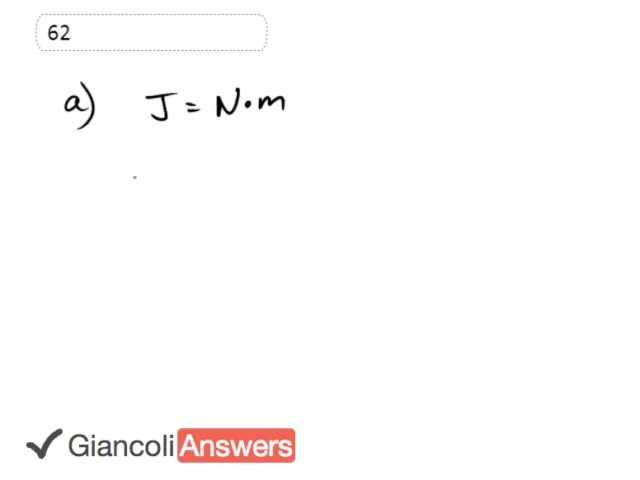
b)
c)
d)

In order to watch this solution you need to have a subscription.
As we're converting Kilowatt hours into Joules, let's keep in mind that a Joule is a Newton Meter. So we'll have Kilowatt hours here that equals 1,000 Watt hours. And a Watt is a Newton Meter per second. 1,000 Newton Meters per second, because Watts are found by going work, which is force times distance, divide by time, which is seconds. So we have 1,000 Newton Meters per second, times the hour. It's still from here. And then we'll take that and go 1,000 Newton Meters per second, times hours, and then we'll get rid of that time there. We'll change the hours into seconds, 3,600 seconds for every hour, and as it turns out, we cancel out the seconds too in this process, and so we're only left with Newton Meters and Newton Meters is Joules. So our job is done here. This works out to 3.6 times 10 to the 6 Newton Meters, which we can write down as 3.6 times 10 to the 6 Joules.
In part b we have to take the daily average power use of a family. 520 Watts, times a Kilowatt for every 1000 Watts, so we want to know how many Kilowatts that is. So that's .520 Kilowatts, then we'll multiply that by the amount of time. We want that time to be in hours, because we're looking for Kilowatt hours. So in a month we have 24 Hours per day, times 30 days per month, approximately. That gives us 720 hours per month. So we take the .520 Kilowatts and multiply that by the number of hours, and we get Kilowatt hours. So this makes 374.4 Kilowatt hours every month. We should actually write that as two significant figures, 3.7 times 10 to the 2 Kilowatt hours. So that's the answer for part b, for the 6th edition.
In c, we'll take that answer, and multiply it by our conversion factor between Joules and Kilowatt hours. Which we actually figured out here. So for every 1 Kilowatt hour, there's 3.6 times 10 to the 6 Joules, So we have 3.744 times 10 to the 2 Kilowatt hours, times 3.6 times 10 to the 6 Joules, for every Kilowatt hour. And that makes 1.3 times 10 to the 9 Joules. That's the part c answer.
Then part d, how much will this cost in a month. So we have 3.744 times 10 to the 2 Kilowatt hours, times 12 cents for every Kilowatt hour. This is $44.93, which we should write with two significant figures as, about $45 per month. And you can actually buy the little devices that go into the wall outlet, to figure out how many Kilowatt hours your device, something else takes, if you plug your computer into this little gadget, this little box here, have between it and the outlet, and it will tell you how many Kilowatt hours that computer takes. And you can figure out how many Kilowatt hours it would use in a month, and then figure out the actual cost of running that thing. So you might hook that up to your refrigerator too for example. It's called a Kilowatt Meter. You can find them on electronic stores or e-bay. So let's go over this with the 5th edition numbers; and we'll be changing this 520 Watts to 500 Watts instead. So that's .500 Kilowatt for the 5th edition. That carries through to here, .500 Kilowatts. Giving a 5th edition answer to part b of 3.6 times 10 to the 2 Kilowatt hours. And in part c, the answer is actually going to be the same, even though you use 3.6 times 10 to the 2 here, round it to two significant figures, you get the same answer, because it's such a big number. And then down here we have, 3.6 times 10 to the 2 Kilowatt hours, and that carries through to about $43 for the 5th edition.